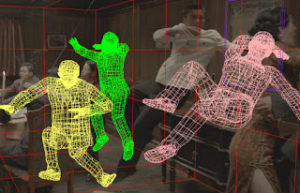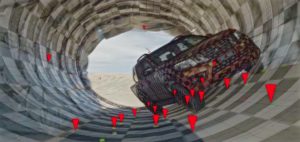
MATCHMOVE : Vfx
May 31 2019
Visual effects play a significant role in film-making, vfx has lot more techniques and effects that come into play, among them is MATCHMOVE.

The process of matching the movement of the live action footage with a virtual camera is called match moving.
Matchmove or Matchmoving, is one of the most important things for today’s VFX processes. It is also referred to as motion tracking and without it one cannot integrate the 3D/CG data into a live action video.
VFX is basically the process of incorporating CG elements with the real-world footage,for example 3D CG generated things or characters are living alongside the actors, we need a virtual camera that moves exactly like the camera in the live action footage. This movement ensure anything that gets rendered out in 3D will be from the same angles as the live action footage at all times. This process of matching the movement of the live action footage with a virtual camera is called matchmoving, because you are trying to match the motions of the camera. There are many different applications with matchmoving capabilities. These programs use a tracking algorithm to lock onto and follow through multiple frames the specific points of real-world footage that an artist has identified. Typically these areas are chosen by the amount of contrast between different areas. This contrast makes it much easier for the motion tracking algorithm to create accurate tracking information. When an area is tracked, it becomes two dimensional coordinates. These coordinates represent the position of the object or feature across multiple frames. Matchmovers create the rough geometry to “fit” into the plate.

Different Forms of Matchmoving
Generally, there are two different forms of matchmoving.
2D Matchmoving: This process only helps track the features in a 2D environment, and does not integrate elements such as camera movement or distortion. If your shot doesn’t include any major changes in camera angles, then 2D tracking will work efficiently. For the reason that 2D tracking doesn’t affect the camera at all, it just carefully examines the footage to see what direction things are moving, and keep track of how they are moving. Therefore, it has limited usage and is mostly employed for replacing or changing the 2D image in the live action footage such as a program running on a TV or the advertisement on a billboard.
3D Matchmoving: 3D animation application to create a virtual camera. With the major advancements in technology, many production studios are utilizing something called real-time matchmoving, which is used heavily in the film industry. It allows the director to get a real-time representation of what the final composite will look like; this includes the 3D elements that are going to be included in post production. a virtual camera that allows the filmmaker to see the real-time representation of what the final footage may look like. This is called as real-time matchmoving and it is becoming popular among many production studios in the film industry.
For example of filming a CAT is jumping across the window which is broken..then it runs through the street.
The director has called for a CG of a Cat to crash out of window of a building and run across the street and into an alley. Because the window is closed cat has to pass through the window, the visual effects supervisor decides that in addition to the CG CAT, the window-shattering effect should also be done in the computer.
During shooting, the cameraman practice the camera move a few times and watch the video playback to see how it looks. When they are filming, they move the camera as though it were following the CG CAT crashing through the window and running across the street, even though the cat isn’t there. the footage is sent off to be digitized and then given to the visual effects artists to add the CAT
When the visual effects studio receives the digitized sequence (known as a plate), they decide that they will need an animator to animate the CAT and a technical director (TD) to do the glass-shattering effect. And, of course, they’ll need a matchmover to matchmove the plate.
The visual effects artists’ goals are to make their 3D elements look as realistic as the scene that was filmed. The animator will need to make the CG CAT move as though it were really crashing through a window, and the TD will need to make the window shatter like a real window. The matchmover needs to figure out where the camera was and how it was moving when the scene was filmed.
Matchmovers play an important role in this case, because in order for the cat and window to appear matched realistically with the scene, they need to make sure that the CG objects are “filmed” the same way with their CG camera as the real set was filmed with the real camera. Consider the window that needs to shatter-if the perspective of the window doesn’t match the perspective in the plate, it will look out of place. Furthermore, if the real camera moves to the left and the CG window stays put, everyone will know it’s a fake.

Matchmove require some experience to judge.
Important points to be considered for Matchmove for a shot :
What does the camera seem to be doing? Is it moving, and if so, how? Is it locked off or panning? How fast is it moving?
What is visible in the shot? Are there tracking markers? Is anything blocking the markers?
What format is the plate? Was it shot on what type of camera and resolution
Is there excessive compression, grain, or noise on the images?
What needs to be placed in the shot? How accurate does it have to be?
Who will be using the matchmove, and how will they be using it?
The MatchMove artist is responsible for reproducing the geometry, camera movement and object movement of a live-action shot in a 3D environment. And is responsible for 3D rotoscoping, for transformation of characters, face, hand and leg replacements and 3d objects for interactions and shadow. A mid-level MatchMove Artist must have experience on a range of large scale film projects encompassing a wide range of camera moves / object tracks and 3d rotoscoping.
CJ Rajkumar
Author/Cinematographer
